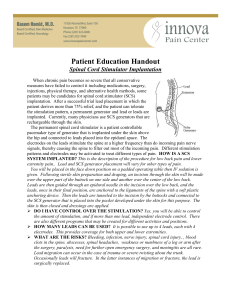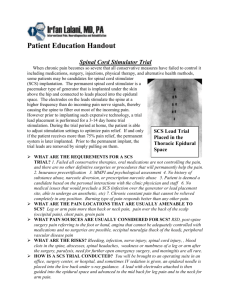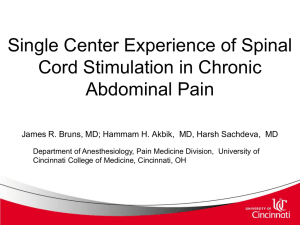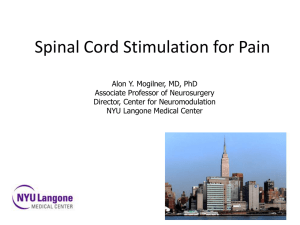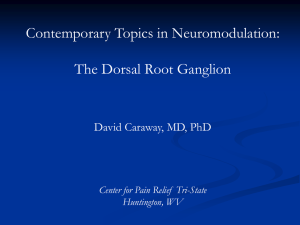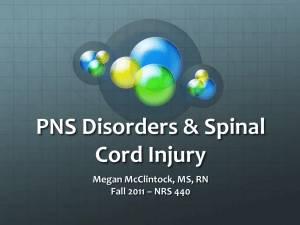Cost-effectiveness of Spinal Cord Stimulation for Failed Back
advertisement
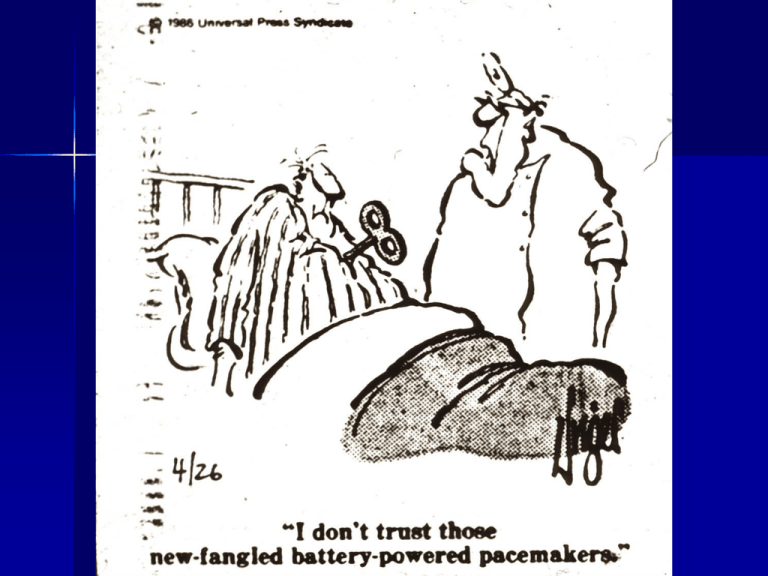
Cost-effectiveness of Spinal Cord Stimulation for Failed Back Surgery Syndrome Using Rechargeable Equipment Richard B. North, MD1 Rod S. Taylor, PhD2 Jane Shipley, BA3 Anthony Bentley, BSc4 1Berman Brain & Spine Institute, Baltimore, MD 2Peninsula Medical School, Universities of Exeter and Plymouth, Exeter, UK 3The Neuromodulation Foundation, Baltimore, MD 4Abacus International, Bicester, UK This study is sponsored by Medtronic, Inc. Disclosures Richard B. North, MD Research support to Johns Hopkins University and Sinai Hospital (former and current employers) Support to nonprofit Neuromodulation Foundation, Inc. (unpaid officer), 2007 - present Autonomic Technologies, Inc. Bioness, Inc. Boston Scientific Corp. Medtronic, Inc. Microtransponder, Inc. St. Jude Medical Neuromodulation, Inc. Consulting/equity Algostim, LLC JHU-APL 1975 JHU-APL-Pacesetter 1979 Primary cell capacity - Botero Charging Made Simple – Portable- cordless & lightweight – Charge on the go – Stimulation on while charging – Charge every couple of days or every couple of weeks-as patient prefers (now Boston Scientific) 2004 2005 Introduction SCS cost-effectiveness is affected by the battery life of the implanted pulse generator (IPG) because battery replacement requires new equipment and a surgical procedure. Introduction Rechargeable IPGs are more costly than non-rechargeable systems, but they offer clinical advantages by: • reducing the need for surgical procedures (expense, risk) •accommodating treatment of patients with high energy demands •supporting complex programming NICE Model In 2008, the United Kingdom’s (UK) National Institute for Health & Clinical Excellence (NICE) evaluated SCS. Using the NICE cost-effectiveness model, we reported that rechargeable IPGs are more cost-effective than nonrechargeables that last <4 years. Taylor RS, et al. The cost-effectiveness of spinal cord stimulation in the treatment of failed back surgery syndrome. Clin J Pain 26(6):463-469, 2010. UK vs. US Practice and cost differences between the US and the UK mean that the NICE model is only generally relevant to the UK. Incorporating these differences into the model allows us to test the impact in the US of several variables, including IPG longevity. Study Question From the perspective of US healthcare payers, we examined the impact of using a rechargeable IPG on the cost-effectiveness of SCS plus conventional medical management (CMM) versus 1) reoperation and 2) CMM alone. Methods: Model The two-stage EXCEL model involves a 6month decision tree and a long-term Markov model. We conducted 1) probabilistic sensitivity analyses to account for uncertainty in assumptions and 2) one-way sensitivity analyses for each SCS indication (tornado diagram) to test impact of changes on the base case assumptions. 6-Month Decision Tree Methods: Data Sources For the probability of clinical events occurring and the probable effect of treatment on quality of life, we used data from RCTs, systematic reviews, and longterm observational studies. We obtained US reimbursement figures from MarketScan® and Medicare, used midpoint cost values, and applied a 3.5% discount rate to costs and health benefits. Results Assuming an implant cost of $25,997 and 9-year longevity for a rechargeable system : SCS is dominant compared with reoperation (both less expensive and more effective). SCS versus CMM yields an incremental cost effectiveness ratio (ICER) of $31,343 per qualityadjusted life-year (QALY), which is cost-effective at a maximum willingness to pay threshold of $50,000. SCS vs. reoperation SCS vs. CMM References – Literature on Use Bernstein CA,, et al. Spinal cord stimulation in conjunction with peripheral nerve field stimulation for the treatment of low back and leg pain: a case series. Neuromodulation 11(2):116-123, 2008. Deer T, et al.. Initial experience with a new rechargeable generator: A report of twenty systems at 3 months status postimplant in patients with lumbar postlaminectomy syndrome. Abstracts of the 9th Annual Meeting of the North American Neuromodulation Society, Nov 10-12, 2005, Washington, D.C. Frank L, et al. Rechargeable SCS systems with independent current control benefit patients and the health care system: Case reports [abst]. Eur J Pain 11(S1):S144, 2007. North RB, et al. A clinical study of spinal epidural stimulation for the treatment of intractable pain. Baltimore, MD: Johns Hopkins University Applied Physics Laboratory, 1977. Oakley JC, et al. A new spinal cord stimulation system effectively relieves chronic, intractable pain: A multicenter prospective clinical study. Neuromodulation 10(3):262278, 2007. Prager J. New rechargeable spinal cord stimulator systems offer advantages in CRPS treatment. Pain Practitioner, 16(1): 68-70, 2006. Van Buyten JP, et al. The restore rechargeable, implantable neurostimulator: Handling and clinical results of a multicenter study Clin J Pain 24(4):325-334, 2008. References-Literature on Cost Hornberger J, et al. Rechargeable spinal cord stimulation versus non-rechargeable system for patients with failed back surgery syndrome: a cost-consequences analysis. Clin J Pain 24(3):244-252, 2008. Kemler MA, et al. The cost-effectiveness of spinal cord stimulation for complex regional pain syndrome. Value Health 13(6):735-742, 2010. Kumar K, Bishop S. Financial impact of spinal cord stimulation on the healthcare budget: a comparative analysis of costs in Canada and the United States. J Neurosurg Spine 10(6):564-573, 2009. Taylor RS, et al. The cost-effectiveness of spinal cord stimulation in the treatment of failed back surgery syndrome. Clin J Pain 26(6):463-469, 2010. Conclusions In the US, our model shows that SCS using a rechargeable IPG is costeffective versus CMM and dominant versus reoperation. The costeffectiveness of SCS is sensitive to IPG longevity. Comparative efficacy - Marketing Economic modeling Rechargeable cell power PRO – Surgical replacement deferred – Less bulk, as smaller cell adequate – Power availability CON – Recharging Inconvenience Noncompliance
